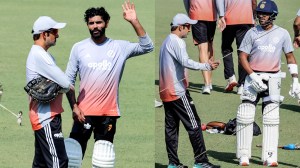Ship of state sails on mirage, drowns in sand
Unlike the Catholic faith, Hinduism does not have a Pope. Nor is there the equivalent of a parish or a jamaat. The practice of Hinduism can...

Unlike the Catholic faith, Hinduism does not have a Pope. Nor is there the equivalent of a parish or a jamaat. The practice of Hinduism can be a very private affair. Alternatively, it can also be a very public matter. Witness the number of people who are attracted to temple car festivals (rath yatras), religious discourses and kumbh melas.
The first attempt to institutionalise Hinduism was made by Adi Shankara. He established mutts. There is a dispute whether the Kanchi Kamakoti mutt at Kancheepuram in Tamil Nadu was established by Adi Shankara. However, there is no gainsaying that it is the most active and most prominent Shankara mutt in the country. The late Shankaracharya, Swami Chandrasekhara Saraswati, was a true sage. Through his lectures and writings he made an exceptional contribution to Tamil literature.
Swami Chandrasekhara Saraswati had another remarkable quality. He steered clear of politics. While he counted many political leaders — including Presidents and Prime Ministers — among his admirers, he did not enter the thicket of politics. That is not to say that he did not reflect on contemporary or mundane issues. He held strong views, but expressed them, rarely and quietly, in private conversations. His successor, Swami Jayendra Saraswati, the current Sankaracharya, is a very different person. He has shown great acumen in expanding the Kanchi mutt’s activities. In recent years, the Kanchi mutt has acquired hospitals, poured in money and upgraded them into institutions of high quality. Evidently Swami Jayendra Saraswati has also a shrewd business mind. The hospitals are sound investments.
The Kanchi mutt is also doing pioneering work in education. It has established schools and colleges — the cluster is now a deemed university — near Kancheepuram. By all accounts Swami Jayendra Saraswati has a good understanding of the frontiers of knowledge. Hence, he has placed emphasis on subjects like information technology and bio-sciences.
Over the years, the Kanchi mutt has sought to enlarge the space for its influence. It is not an accident that some of this new space has encroached upon the space reserved for government and politics. In this effort, Swami Jayendra Saraswati has been immensely helped by the fact that some of his ardent followers — mostly Brahmins — were or are in key positions in the Central Government and in the Government of Tamil Nadu. Among them are Mr. R Venkataraman, Mr. P V Narasimha Rao, Ms. Jayalalithaa, Mr. Murli Manohar Joshi and numerous civil servants.
I have a sneaking suspicion that, in this role, Swami Jayendra Saraswati has taken Pope John Paul II as his model. The role played by the Pope in the democratisation of the Eastern Europe countries and Russia is well known. I am not alone in thinking that, perhaps, Swami Jayendra Saraswati also, according to his own light, is attempting to redefine the constitutional basis of the Indian republic. There are many Indians who do not accept the principle of a secular India. They want India to be a Hindu republic. Not all of them are bigots, but they do not accept the principle of equality between Hinduism and other faiths. In their view, India is and must be a Hindu country where people belonging to other religions are allowed to live and prosper. Swami Jayendra Saraswati believes that Hinduism is entitled to primacy and a predominanting position in the life of the country. He is a Hindu seer, and it is natural for him to believe so. Where Hindu aspirations come into conflict with the aspirations of people belonging to other faiths, it would be unwise to expect Swami Jayendra Saraswati to remain neutral. In matters such as the controversy surrounding the Babri Masjid-Ram Janmabhoomi he can never be an impartial mediator. He is an acknowledged representative of Hinduism and only the very naive could have believed that he would be able to find an amicable solution to the vexed issue.
Was there anything fair or impartial in Swami Jayendra Saraswati’s first letter of June 16, 2003, to the All India Muslim Personal Law Board (AIMPLB)? He wanted the Board to give a no-objection letter for the construction of a Ram temple on the undisputed site. As regards the ‘‘disputed’’ site, on which the Masjid once stood, he promised to protect the same by constructing a wall and offered that the ‘‘disputed site can be discussed later’’. The June 16 letter was a faithful restatement of the Government’s position. This is precisely what the Government sought to push through, in its own clumsy way, until it was rebuffed by the Supreme Court.
The July 1, 2003, letter went further than anyone could have imagined. Pressured by the visits of VHP and RSS leaders, Swami Jayendra Saraswati urged the Muslim community to donate the disputed site to the Hindus and added that Kashi, Mathura and Ayodhya belong to the Hindus and hence the ‘‘Muslims have to mentally prepare for this’’. This letter could as well have been written by the VHP or the RSS. In putting his name to the letter, Swami Jayendra Saraswati was brazenly pushing the RSS-VHP agenda. Perhaps he was emboldened to do so by the belief that the AIMPLB and the Muslim community would be overwhelmed by the tide of public opinion and they would meekly yield to these unacceptable and one-sided demands.
Mercifully, there was no tide of Hindu opinion in favour of Swami Jayendra Saraswati. Even the politicians, including Prime Minister Vajpayee, who readily yielded their space to the seer, have backtracked and disowned any knowledge of the contents of the two letters. What a farce? By his intervention, Swami Jayendra Saraswati has only widened the divide between the two communities.
There are lessons for all. Government cannot abdicate its responsibilities. All disputes must be resolved through the established organs of the Republic — the executive, the Parliament and the judiciary. Religious leaders can never be neutral or impartial in matters involving the clash of religious interests. Swami Jayendra Saraswati attempted to enlarge the space for himself and his mutt only because political leaders were ready to yield that space. Both were wrong. The best statement from the seer was that he would no longer interfere in the Ayodhya dispute. That statement, I believe, follows the great tradition established by his predecessor, Swami Chandrasekhara Saraswati — a tradition of detachment and silence that elevated him to the status of a living god.
Write to the author at pcexpressindia.com





- 01
- 02
- 03
- 04
- 05


























